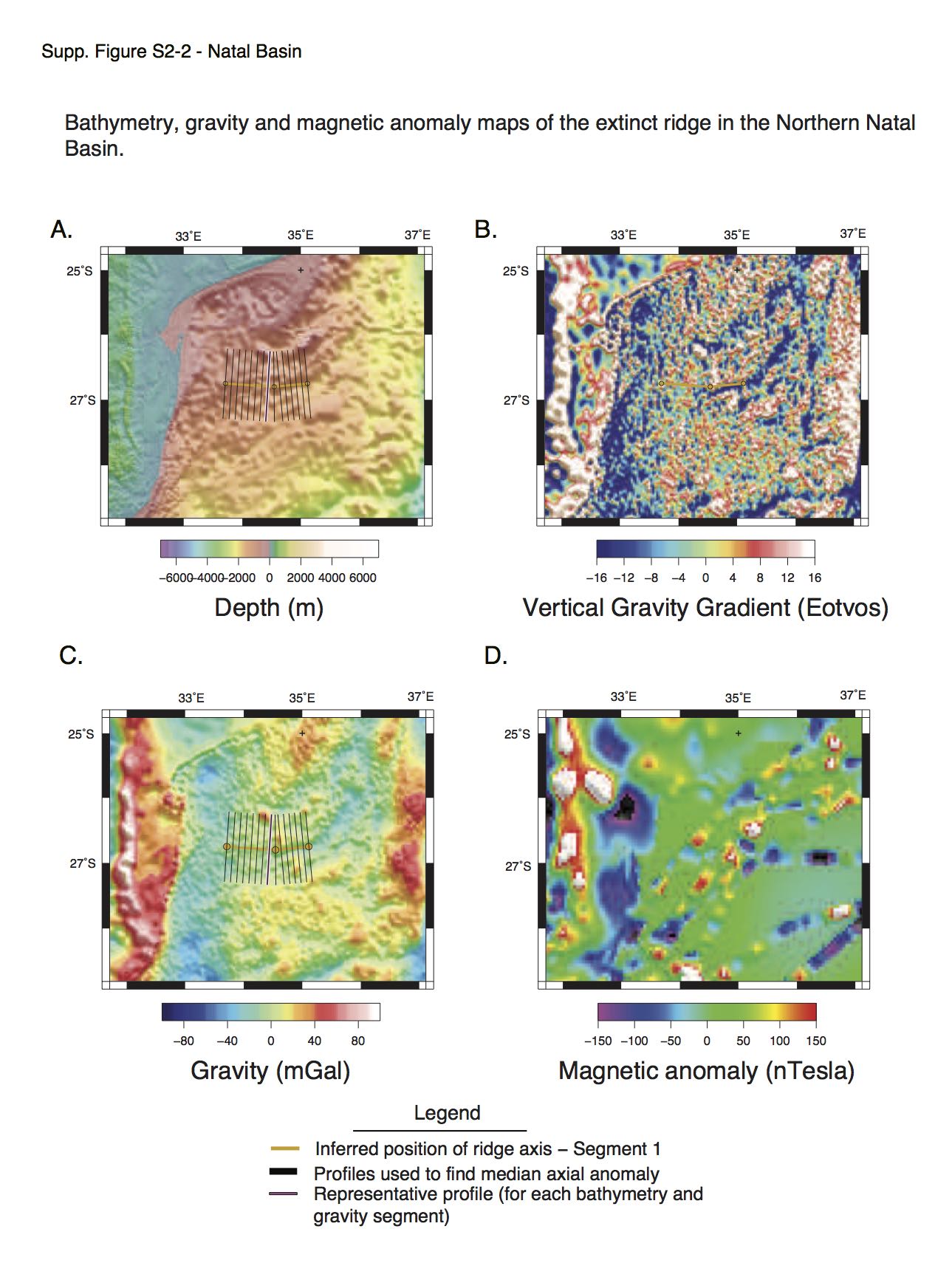| Ocean: | Indian |
| Spreading center type: | Large-scale extinct MOR |
| Time of cessation: | M2, ca. 124 Ma (Tikku et al., 2002) |
| Subsequent active spreading center: | Present-day configuration of the Southwest Indian Ridge |
| Cessation style: | Argued to have been an abrupt cessation (Tikku et al., 2002) |
| Later deformation or volcanism: | Volcanism within the last 10 ^4 yrs has been suggested |
Martin and Hartnady (1986) proposed that an extinct spreading ridge was required in the Northern Natal valley, in order to avoid significant overlap of the Mozambique Ridge in a Gondwanan full-fit assembly, because they proposed that the Mozambique Ridge was atl least in part composed of a continental fragment. While the northern Natal Basin isfeatures thick sedimentary sequences and a hummocky morphology that makes identification of the tectonic fabric difficult, Tikku et al. (2002) proposed that an extinct spreading axis could be identified, that may have been active concurrently with the Mozambique Basin-Riiser Larsen spreading system. Tikku et al. (2002) proposed that 170 km of oceanic crust had been formed at this extinct center between M11 and M2, synchronous with contemporary spreading in the West-Somali Basin and in the Riiser-Larson Sea. Tikku et al. (2002) agree that the Mozambique Ridge is likely to contain some continental material, citing studies reporting the collection of continental rocks from dredged samples on the eastern side of the ridge (Ben-Avraham et al., 1995). They propose that the Mozambique Ridge may have acted as an independent microplate during the seafloor spreading episode to the west of the ridge (Tikku et al., 2002).
Ben-Avraham et al. (1995) proposed that the southern Mozambique Ridge continental fragment may have been adjacent to Dronning Maud Land on the Antarctic margin, prior to Gondwanan dispersal and they argue that migration of the original spreading center to the south occurred prior to the microcontinent becoming fixed to the African plate. Later studies propose that rifting of the Antarctic-African margin was synchronous along the entire margin, with Madagascar fixed to the Antarctic plate until after cessation of spreading in the West Somali Basin, and these models generally believe that the Mozambique Ridge is made up of oceanic crust and lacking a continental core (for example Maia et al., 1990).
A second extinct ridge has been suggested within the Transkei Basin by Ben-Avraham et al. (1995), who propose that the Aguhlas Plateau is ‘firmly’ established as continental crust (from dredge samples of gneissic rocks of 1 Ga age) and that this necessitates an additional ridge jump to isolate the theorised microcontinent. Ben-Avraham et al. (1995) proposed that the Aguhlas Plateau microcontinent was adjoined to the eastern Falkland Islands prior to rifting during the Cretaceous Normal Superchron. This would be compatible with Barker's (1979) interpretation of the Aguhlas extinct ridge being the latest of two or three westward migrations of the active spreading center between Southern Africa and South America.
Tikku et al. (2002) observed that the gravity anomaly associated with the inferred extinct ridge was of very low magnitude (only a few mGals), which was within the instrumental error or noise. Tikku et al. (2002) infer that the transfer of the spreading center to the south was likely as a result of changed tectonic boundaries to the west, as the Falklands separated from a position offshore Antarctica and as the plate boundary simplified between Africa and Antarctica to a two plate system.
Identification of symmetric magnetic anomalies within the northern Natal Basin (Tikku et al, 2002) strongly supports the presence of an extinct ridge in this location, there is no obvious indication from our review of maps and profiles in the inferred position of the extinct spreading axis. Several profiles are found to display a negative gravity anomaly of ca. 10-15 mGals and this could potentially reflect the former axis, as it is a in similar range as the West Somali Basin segments that are of a similar age.
Barker, P.F., 1979, The history of ridge-crest offset at the Falkland-Agulhas Fracture Zone from a small-circle geophysical profile, Geophysical Journal International, v. 59, no. 1, p. 131–145.
Ben-Avraham, Z., Hartnady, C.J.H. and Roex, A.P., 1995, Neotectonic activity on continental fragments Agulhas Plateau and Mozambique Ridge, Journal of Geophysical Research, v. 100, no. B4, p. 6199–6211.
Maia, M., Diament, M. and Recq, M., 1990, Isostatic response of the lithosphere beneath the Mozambique Ridge (SW Indian Ocean) and geodynamic implications, Geophysical Journal International, v. 100, p. 337–348.
Martin, A. and Hartnady, C.J.H., 1986, Plate tectonic development of the South West Indian Ocean: a revised reconstruction of East Antarctica and Africa, Journal of Geophysical Research, v. 91, no. 5, p. 4767–4786.
Tikku, A., Marks, K. and Kovacs, L.C., 2002, An Early Cretaceous extinct spreading center in the northern Natal Valley, Tectonophysics, v. 347, p. 87–108.


